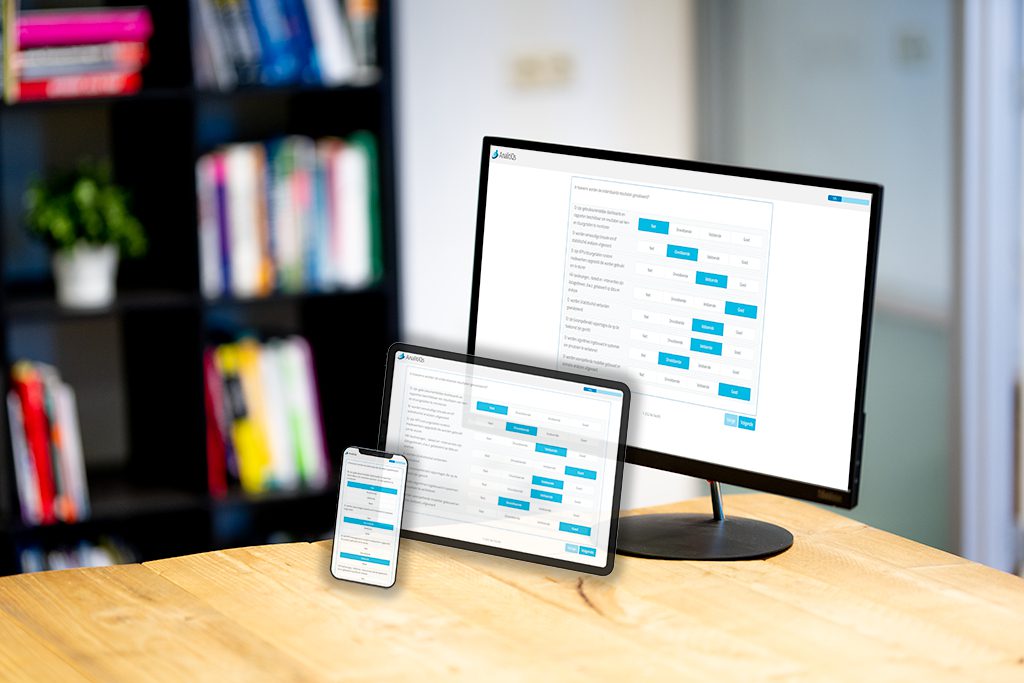Once upon a time virtually every organization performed a (bi-)annual engagement survey consisting of about 40 to 60 statements ranging from Engagement to Manager satisfaction.
In the last decade this practice started to shift. Organizations started moving away from irregular, lengthy point in time surveys towards continuous employee listening. This page describes:
- What is continuous employee listening?
- Why are organizations adopting continuous employee listening?
- What are examples of continuous employee listening?
- How to design and implement a coherent continuous employee listening strategy?
- What tools/technology to use for continuous employee listening?
- What are tips for successfully implementing continuous employee listening?
- Which questions are frequently asked about continuous employee listening?

Questions about Employee Listening? Feel free to contact us!
What is continuous employee listening?
Continuous employee listening is a concept that has different aspects to it:
- It is the ongoing process of gathering feedback, opinions and suggestions from potential employees, current employees and alumni. Sometimes also referred to as the Voice of the Employee.
- It focuses on the entire employee lifecycle; attract, recruit, onboard, develop, retain and leave.

- Ideally, various methods are used, ranging from quantitative to qualitative and from pro-active to re-active methods.

Why are organizations adopting continuous employee listening?
The adoption of continuous employee listening has a pull and a push element to it.
- The pull element: we are living in a world that is constantly changing, in which talent is scarce, employees leave when they aren’t satisfied and in which talent preferences/needs are constantly evolving. Therefore, a once-a-year engagement survey simply doesn’t suffice anymore, and organizations are looking for better ways to gauge and optimize employee experience (EX).
- The push element: we are living in a world with a tremendous amount of data and technological innovation. As a result, there are better, more effective ways to measure employee experience (EX) than a while ago, for instance through text analysis and system log data.
If this is translated into more tangible goals, organizations adopting continuous employee listening often cite one or more of the objectives below:
- To stay competitive: companies are aware that engaged and satisfied employees are more productive and provide better customer service.
- To identify areas for improvement: continuous feedback from employees helps organizations identify areas where they can improve employee journeys, policies, and work environment.
- To retain employees: by listening to employees and addressing their concerns, organizations can reduce employee turnover and retain top talent.
- To stay ahead of changing employee needs and expectations: the world of work is constantly evolving, and companies that listen to employees are better equipped to respond to changes.
Click here to return to the table of contents.
Examples of continuous listening
Many people associate continuous employee listening with surveys. For most organizations this is a fair association. However, surveys are nowadays often replaced by other, more innovative, means of employee listening. Below are traditional and more innovative survey examples, but also non-survey examples of continuous employee listening. To AnalitiQs’ experience the best continuous employee listening programs combine multiple methods.
Surveys
Pulse polls: short, frequent surveys that quickly gauge employee sentiment on specific topics such as hybrid work and well-being.
Continuous employee journey surveys: such as exit surveys filled out by departing employees to gather insights into, amongst others, their experience, reasons for leaving and the new employer. Or onboarding surveys querying new hires about their experiences during, and improvement suggestions for, the onboarding journey.
Website intercept surveys: website pop ups/banners asking employees to leave their feedback and submit improvement suggestions.
Qualitative research
Focus groups: structured discussions where employees can provide more in-depth feedback and insights on specific topics or initiatives.
1-on-1 meetings: regular meetings between employees and managers to discuss their concerns, experiences, and suggestions for improvement.
Other means of continuous employee listening
Analyzing Search Portal: search bar entries and results, thereby improving employee support, read more in this case study.
Employee sentiment analysis: using machine learning algorithms to analyze employee-generated data, such as emails and chat messages, to understand sentiment and identify areas for improvement.
Want to get started? We are here to design and implement continuous employee listening with youClick here to return to the table of contents.
How to design and implement a continuous employee listening strategy
Definition: In this phase a wireframe for continuous listening should be developed. What are the key topics to focus on? What parts of the organization and/or employee segments should you focus on? What are the burning people themes and which questions need to be answered? Which insights are required to answer these questions? What key principles to adhere to?
Tip: dream big, act small and start tomorrow with a small number of topics.
Channels: Decide on the methods that will be used to gather feedback, such as surveys, focus groups, text analysis, sentiment analysis, etc.
Tip: too many surveys will lead to survey fatigue, are there other ways to collect feedback?
Plan: Map out the timing, frequency, and scope of each feedback channel. But also, determine roles and responsibilities for measuring, analyzing, communicating, and acting on the feedback.
Tip: the value of continuous employee listening is determined by the ability to act on insights, cater for robust communications and change management. Don’t ask input on topics that will not be addressed.
Communicate: make sure employees understand the purpose of the continuous listening program, how their feedback will be used and how their privacy is safeguarded. Encourage them to participate.
Tip: ensure top management commitment, let them explain the rationale for continuous listening and make sure they walk the talk.
Listen: gather feedback from employees through the identified channels.
Tip: write and socialize a robust privacy statement in which the basis for processing has been made explicit in plain language
Analyze: use data visualization techniques and data science to interpret the data and generate insights.
Tip: look beyond averages and traditional organization hierarchies, use data science techniques to create segments and to uncover engagement drivers/predictors.
Act on feedback: develop action plans to address the issues and concerns that emerge from analyzing the employee feedback. Communicate the results and progress with employees.
Tip: recognize and reward employee contributions.
Continuous improvement: Regularly evaluate and adjust the continuous listening program to ensure that it continues to meet goals and utilizes all technical possibilities.
Tip: involve employee representatives.
Appreciate support with designing and implementing a continuous employee listening program? We are there to helpClick here to return to the table of contents.
What tools/technology to use for continuous employee listening?
At AnalitiQs we deploy two tools for employee surveys.
Our own survey platform
- Predefined, validated constructs for many trending HR topics, e.g. engagement, inclusion, leadership and many more;
- Ability for clients to change and/or add questions;
- Multi device, intuitive survey user interface;
- Online dashboard with role based access, benchmark and filter functionality.

CircleLytics
CircleLytics is a solution for conducting dialogues with groups of people. A dialogue with CircleLytics follows a two-round process through which ‘advancing insight’ and reflection takes place. The real undercurrent comes to the surface. The best results and a unique insight into the supporting base are available immediately and in real time.
Click here to return to the table of contents.
What are tips for implementing continuous employee listening?
- Make it accessible: consider using text messages or WhatsApp next to email for survey invites.
- Encourage honesty: Ensure that employees feel comfortable sharing their opinions and concerns and create a culture of trust and confidentiality. Be transparent about privacy.
- Provide incentives: Consider providing incentives for employees who participate in the program to increase participation and engagement.
- Lead by example: Demonstrate the importance of continuous employee listening by involving senior leaders, making it a priority for the organization, and making actual changes to processes, policies, systems, etc.
- Guarantee data access: employee experience data is extremely valuable for HR data science. For dubious reasons, some vendors do not share data with their clients however. This is an impediment when developing diagnostic and predictive models. Agree with your survey vendor under which conditions they must share your organization’s data and if there are costs attached to it.
- Focus less on response rate: obviously a high response rate is nice. Equally, a response rate of 20-30 % is typically sufficient to create reliable insights, especially when a check and mitigating measures for over/under representation are performed.
Which questions are frequently asked about continuous employee listening?
How to prevent survey fatigue?
- Use different channels than surveys;
- When using surveys, keep it brief by only asking questions that receive follow up;
- Work with samples;
- Use personal data from HR systems to avoid questions about demographics.
How to boost employee survey response?
- Run a communications campaign before launching the survey;
- Personalize the invitation;
- Offer anonymity;
- Keep the survey concise;
- Make it a conversation by using Circlelytics;
- Show employees their voice is heard, and their suggestions lead to actual change.
Which (HR) role/department should own continuous employee listening?
Since continuous employee listening involves data, privacy and analysis it should be owned by the People/HR Analytics team.
Do employees need to give consent?
Whether employees need to give consent for continuous employee listening will depend on the specific policies and laws of the country or region in which the organization operates. In many jurisdictions, employers are allowed to gather feedback from employees as long as they inform employees of the purpose of the feedback and how it will be used.
How does continuous employee listening relate to employee experience, touchpoints that matter and employee journey mapping?
Continuous employee listening is related to these topics in several ways:
- Employee experience: continuous employee listening helps organizations understand how employees feel about their work experience, including factors such as work culture, benefits and opportunities for growth and development. This information can be used to improve the overall employee experience and create a more engaging and supportive work environment.
- Touchpoints: continuous employee listening can identify key moments in the employee experience that are meaningful or impactful, such as onboarding, training, performance evaluations and other interactions. This information can help organizations understand which touchpoints are most important to employees and focus their efforts on improving these moments.
- Employee journey mapping: employee journey mapping is the process of visualizing these stages and touchpoints in the employee experience.
Continuous employee listening can provide valuable data and insights for mapping the employee experience and journey, allowing organizations to identify areas for improvement and develop strategies to improve the employee experience.
Interested? Contact us!

Gido van Puijenbroek
Detailed Service Overview
HR Analysis
Equal Pay
Gender mobility
Absenteeism
Employee Segmentation
Employee Retention & Attrition
Engagement
Impact Measurement / ROI
Learning & Development
Management Development
Onboarding
Organisational Network
Performance
Process Mining
Productivity
Recruitment
Restructuring / Organizational-Development
Reward
Strategic Workforce Planning
Succession Management
Employee Surveys
Culture
Employee Satisfaction
Job Satisfaction
Inclusion
Onboarding
Employee Turnover
Diversity
Employee Community / Panel
Employee Engagement
Employee Commitment
Employee Journey
Employee Net Promotor Score (eNPS)
Employee Value Proposition (EVP)
Employee Enthusiasm
Labour Market
Labour Market Panel
Labour Market Positioning
Leadership
Manager Feedback
Personal Development
Pulse
Retention
Role Clarity
Sentiment
Strategic Alignment
Team Feedback
Total Reward Optimization
Voice of the Employee (VoE)
Work from home
Work Stress
Work Pressure
Capability Building
HR Analytics Strategy
HR Analytics Product Owner
HR Analytics Outsourcing
HR Academy
HR Dashboards
Absenteeism Dashboard
Integral HR Dashboard
Leadership Dashboard
Learning Dashboard
Recruitment Dashboard
Reward Dashboard
Talent Development Dashboard



